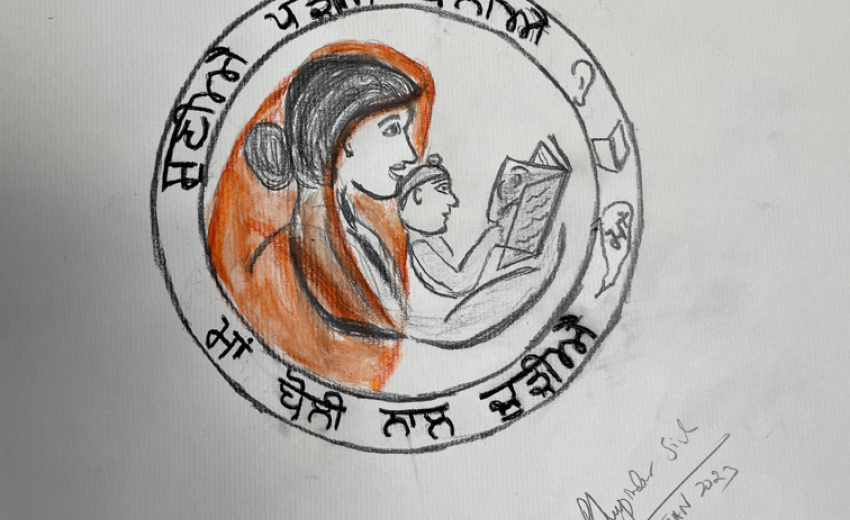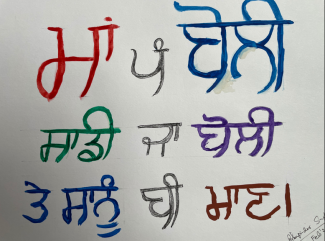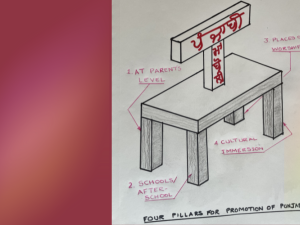Introduction
The International Mother Language Day falls on February 21, but this year, for me, its reminder arrived exactly a month earlier when I read the news item about the Canadian Government agreeing to settle a class action claim “seeking reparations for the loss of language and culture brought on by Indian residential schools, for $2.8 billion.” My mind was filled with thoughts and feelings for the loss of the Indian tribes. Suddenly a thought occurred, wait, this could be fate of my mother tongue too, if we fail to safeguard and make efforts to preserve it. The language which is mother tongue of over 130 million is endangered today, as it is not being taught, spoken, or propagated. The official apathy extends on the either side of the border that divides Punjab. It is a pretty grim and alarming reality which should be a wake-up call for us. A wake-up call from our slumber before it becomes too late and it becomes an extinct language.
We may claim pride in our heritage, but we fail to exhibit it, by shying from speaking in Punjabi. We claim we are Punjabi by nature and food, but our speech does not reflect it. It will be no exaggeration to say that when it comes to our mother tongue, we have been carrying a self-perceived inferiority complex. In fact, Guru Nanak Dev Ji (1469 -1539) observed this trait in Punjabis over 500 years back, as reflected in these words:
ਘਰਿ ਘਰਿ ਮੀਆ ਸਭਨਾਂ ਜੀਆਂ ਬੋਲੀ ਅਵਰ ਤੁਮਾਰੀ ॥੬॥
“Ghar ghar mian sabhanaa(n) jeeaa(n) bolee avar tumaaree. 6.” (SGGS, Pg. No. 1191)
Translation: In each and every home, everyone addresses using the term “Mian” for greetings; your speech has changed, O people. ||6||
That was the language of rulers then, but now it has been replaced by Hindi/Urdu and English instead. This inferiority complex is not to be found in Germans, French or Chinese outside India (pre-partition as Bengal and Punjab were divided in 1947). Amongst the Indians Bengalis, Tamilians, Telgus, Gujaratis and Sindhis are very firmly attached to their mother tongue, who will unhesitatingly switch to it as their preferred medium of communication. I am sure I have omitted many other people unintentionally, as this list is not an exclusive list; but simply based on my mental imprints through my interactions with speakers of these languages.
Brief Historical Perspective
The language that I am referring to is Punjabi, which is the common mother tongue of the people of Indus valley. This was the spoken language and employed as the method of communication for ages. During the time of Guru Nanak Dev Ji, he noticed that the scriptural Hindu text were written in Sanskrit, which was not the language of the masses. Therefore, he adopted Punjabi to convey his own ideas so that everyone could understand them and incorporate them in their lives. Thus, Guru Ji was giving to the masses the spiritual insights in the language of common man, instead of Sanskrit which was an exclusive domain and privy of Brahmins. This was a revolutionary step in the process of dismantling the caste structure which had made others dependent on Brahmins for their spiritual, religious, and social needs. The Gurmukhi Punjabi script adopted by Guru Ji was based on Landa.
Fast forward about 300 years to the times of Maharaja Ranjit Singh (1789 – 1839), the literacy in the Khalsa Raj was almost 100%. All places of worship as Gurudwara, Mandir and Masjid could only operate, if they had an attached school for imparting education. All the women were literate in his kingdom. Despite the fact that official court language was Persian, Punjabi was language of the masses. Although, Maharaja himself had received a little formal education, still he was a great education visionary. His strategy for educating the masses was through the Qaida-E-Noor. After the annexation of the kingdom in 1849, the British Indian government started planning the introduction of modern European system of education there. They realized that in order to succeed there they will have to root out Qaida system. The British rulers made sure that nobody in Punjab could read their language as a means to curb resistance. Anybody handing over a gun or sword to the Raj rulers was paid two annas while the one returning Punjabi Qaida was paid six annas. The colonial rulers collected Punjabi Qaidas from village to village and burnt them. Shahzad (2010) is of the view that the English rulers did not use Punjabi as medium of instruction as they knew that by doing so literacy rate in Punjab will increase. These educated people will come to know their rights and would challenge the rule of the invaders. Today, we cannot even find a single copy of this historical Qaida, thus no historical evidence exists.
Here we can see the treatment of the native language at the hands of foreign rulers, who considered their English language to be superior over the native language. At the time of Independence from the British in 1947 the Punjab was divided between India and Pakistan. Now a new indigenous national pride was awakening in these two nations divided on the basis of faith. To show their native pride Urdu was adopted as state language in Pakistan and Hindi in India. Now, the thrust to promote the national language over the entire country became a new reality in the name of integration. The new found thrust was at the cost of preservation of the regional languages. The Urdu in Pakistan, and Hindi in India, along with English become the first language at homes, while the regional languages were considered as the language of rural, rustic, uneducated masses. In West Punjab (Pakistan) the Punjabi speaking population is 60 million, but Punjabi is not taught in schools as per UNESCO report.
The Punjabi Language in Indian Punjab received another jolt when Punjab was divided into Punjab and Haryana in 1966, while some territories of erstwhile Punjab were merged with Himachal Pradesh and union territory of Chandigarh was carved out. Hindi was adopted as the state language in Haryana, Chandigarh and Himachal and the voice of Punjabi speaking people in these territories were totally ignored. To rebuff Punjab, the state of Haryana adopted Tamil as second state language, despite the fact there were hardly any speakers of that language or trained teachers to impart it in the schools. In Indian Punjab the state which was carved based on the language its native language is not enjoying its rightful status as per the three language (English – Hindi – Regional Language) policy.
Now, with globalization, the trend to immigrate out of the country is further accelerating the demise of Punjabi. As the immigrants are driven by the desires of bettering their lives, quickly start assimilating into their new adopted countries. As the parents want their kids to fit in, thus mother language becomes low on the totem pole of life’s priorities. The English thus becomes the first language at homes outside Punjab.
Need to Preserve
UNESCO has published a report (Reference 4) wherein they have clearly advocated the benefits of early learning in the mother language. See under for the highlight from UNESCO report:
“Research shows that education in the mother tongue is a key factor for inclusion and quality learning, and it also improves learning outcomes and academic performance. This is crucial, especially in primary school to avoid knowledge gaps and increase the speed of learning and comprehension. And most importantly, multilingual education based on the mother tongue empowers all learners to fully take part in society.”
The Gurmukhi alphabet which was derived from the Landa alphabet that has roots in the incredibly old Brahmi alphabet. Second Sikh Guru Angad Dev Ji (1539-1552) enhanced the Gurmukhi alphabet to its current state for the express purpose of writing the holy book, giving rise to the slogan “Guru’s mouth” for it.
Now that doomsday alarms have been sounded, let us look at how to avoid this precarious scenario. The efforts will have to be made on multiple fronts. The first place to start the change has to be home. After all, if Sikhi has to survive today then the Sikhs need to get Guru Ji’s message as written by them from its source in “Gurmukhi.” The translations or interpretations will always carry personal understanding including the biases or some taint. For the Sikhs the survival of their language is not just a question of survival of their mother language alone, but preserving the key that opens the door of Guru’s spiritual wisdom and salvation. Thus, the stakes are much higher. Let us explore some areas how this can be pursued.
Using Music
The power of music is phenomenal. The new born are sung rhymes and songs, to lull them to sleep as well as teach them. No wonder Guru Nanak Ji employed the power of music to spread his message by singing his hymns to music scales. In Gurudwaras the devotional singing called Keertan is the primary mode of spiritual discourses. The scientists have found that music stimulates more parts of the brain than any other human function. That's why they see so much potential in music's power to change the brain and affect the way it works. The Punjabi music is very robust, catchy, rhythmic that has gained a strong following outside the Punjabi speaking world. No social functions and weddings are complete without the Punjabi songs. The essential highlights of garbas in Gujarat, Pongal celebration in south, and Bollywood dances are Punjabi songs. We need to ride on that interest wave and create an interest in Punjabi Language. The rhymes and folk songs can become effective tools for teaching the language and making it a preferred language of choice.
Storytelling
Language is the cultural glue that binds communities together and stories become its building blocks. The art of storytelling in family setting is declining, as the family units have metamorphosed from joint families to nuclear families with both working parents. But the power of oral storytelling has not diminished despite the advent of digital devices. The power of storytelling can be used to promote and initiate kids into the language. We need to create more quality illustrated children’s book along with digital stories. We have a repertoire of traditional catchy folktales that have not been exploited as tools for teaching the language. We really need to get such resources developed and properly implemented to gain benefits from it.
Individuals and organizations have made some maiden efforts in this direction, but we need to raise the presentation and quality standards of these initiatives. More efforts are needed on how to disseminate these resources available to the learners for propagating Punjabi along with setting up their distribution centers. Even on the digital platform there is a need to develop additionally such teaching tools. The need of the hour is an author of caliber of Bhai Vir Singh (1872-1957) to inspire us with the love of our mother language and Guru’s teachings through the writings.
Making Movies
The movies may have become a staple of entertainment but there is another potential of the movies - educational. Well besides entertainment this medium provides avenues for cultural and literary immersion, it also makes effective tool to impart students with a deeper understanding of subject through visuals. Its use can be used to supplement the book reading on a boring/complex subject to make it more easily related to. The exposure to movies can inspire students to become involved in the movie making industry by choosing it as their future profession as well. We need to come up with good stories, engaging themes and treatment to make effective use of the medium. We really need a Satyajit Ray (1921-1992) of Punjabi films who can take them to a higher level and gain global recognition. This will in turn generate interest in learning the language.
Making a modern Qaid-E-Noor for today’s world
This will be a nostalgic trip to make a new Qaida to teach Punjabi inspired by the legendary Qaida-E-Noor. Unfortunately, no copy of the legendary Qaida exists that could be used as a model/guide for the newer version. It will have to be a grassroots effort to make a Qaida that is appealing to the learners and for the parents to use it to teach. This is not an untenable initiative, but the best brains will have to pool their talents to come with something exciting like that. The requisite resources and plans to make effective use of Qaida has to be chalked out again using Maharaja’s initiative as the model, then tailoring it according to modern times.
Making Digital Media Content
The computers have changed the world in more ways than the other technologies from the past. It has changed and is continuously changing the way world works. Today even a one-year-old is playing or watching content from the smart phones. In fact, phones have become baby sitters, story tellers, games centers and entertainers for the youngsters. They also present a great tool for teaching; we have to explore its potential and harness it as a tool to teach Punjabi. There are some children’s Disney shows that provide us with templates on how to harness this technology, which is here to stay. This subheading will be incomplete without a mention of online web portal for teaching Punjabi. This should be a complete comprehensive online university which offers diplomas, advanced courses and certificates of completion.
Punjabi Learning Centers
We need to plan Punjabi Learning Centers in line with language teaching institutions being run by some countries to promote their mother language. Some examples are Goethe Institute – German, Alliance Française – French, Confucius Institute – Chinese etc. No government is going to lead such an effort for Punjabi, so we will have to make our own efforts. These institutes running such programs provide us with a template and model and how it can be done. The syllabus, course duration, text books, and other resources need to be developed and standardized. We need to get organized and start, then plant the physical seed in some location. Then the model can be replicated in other cities, and it can be scaled up worldwide, if we can get proper organizational structure and setup. Besides teaching Gurmukhi reading and writing other courses as Gurbani-Santhiya, Keertan etc. can be added to their offerings. We will not only be connecting the future generation to the mother language but to father figure Guru as well in a meaningful way.
Conclusion
We have to realize that raising children in an environment where Punjabi is the ordinary language of daily interaction is central to the survival of our beloved mother language. The onslaught of globalization on the fate of languages without significant speakers is going to be their death knell. The irony of the times is that the pitch for Punjabi language has to be made in English. Thus, the situation is grim, but not hopeless. It requires recognition of the situation we are facing and working on in a concerted efforts at the grassroots level. Let us not go down the history lane as the generation that was complicit in pushing Punjabi to extinction, but the generation that reversed the trend and made it flourish again.
There will be skeptics who may not believe in it. But I can vouch from my personal experience. My father and myself were born in Burma (now Myanmar) and we spoke Punjabi and learnt to read and write Gurmukhi at home. My kids were raised in USA, and we had to put an effort to do it for their sake. Now my grandkids are on this path of learning. So, there is hope, we need to make commitment and develop the requisite resources. So let us all join hands irrespective of our individual faith and rise for the common good that Punjabi language matters. We are citizens of world, so no language is despised by us, but we only exist when our mother tongue is revered by us as reflected in its usage by us. The picture of the consequences of neglect as painted By Guru Nanak Ji is:
ਖਤ੍ਰੀਆ ਤ ਧਰਮੁ ਛੋਡਿਆ ਮਲੇਛ ਭਾਖਿਆ ਗਹੀ ॥
“Khatreeaa ta dharam chhoddiaa malechh bhaakhiaa gahee.” (SGGS, Pg No. 662)
Translation: The protectors (Khatris) have abandoned their religion and have adopted a foreign language.
References:
- https://www.cbc.ca/news/canada/british-columbia/residential-school-band-class-action-settlement-1.6722014
- https://patch.com/connecticut/trumbull/history-of-punjabi-language--gurmukhi-alphabet
- https://www.quora.com/How-did-Tamil-became-the-second-official-language-in-Haryana
- Shafi Aamir. Punjabi Parents’ Perception of Punjabi as Their Children’s Mother Tongue https://www.numl.edu.pk/journals/subjects/1566368197Punjabi%20Parents%20...
- https://www.unesco.org/en/articles/why-mother-language-based-education-essential
UNESCO Report: MOTHER TONGUE MATTERS: LOCAL LANGUAGE AS A KEY TO
EFFECTIVE LEARNING. 2008







